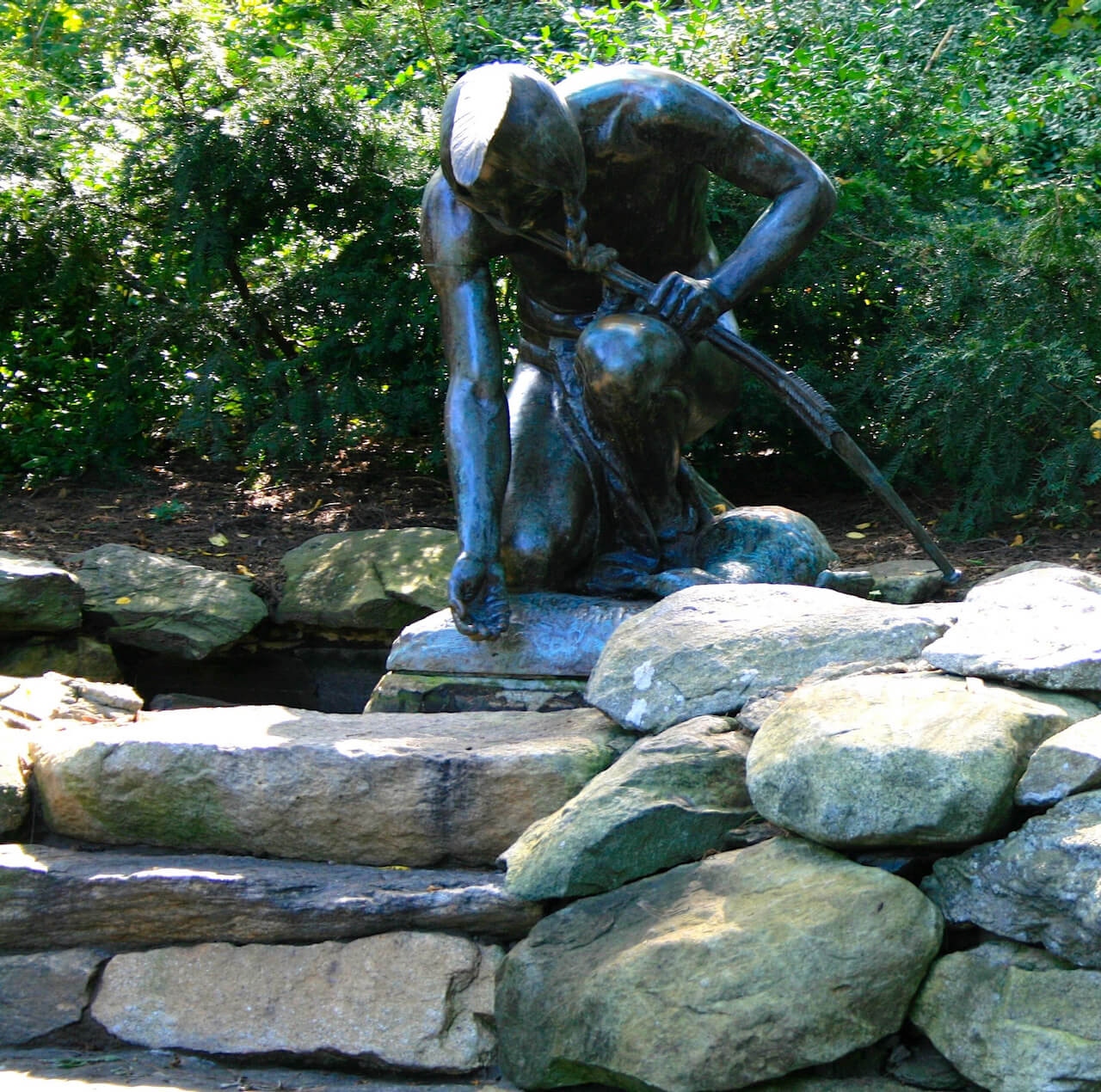Cyrus Edwin Dallin, Sculptor
Robbins Park, Arlington, MA
Dallin created the bronze Menotomy Hunter in 1911, more than one hundred years ago. The Native American hunter, kneels beside a stream for a drink of water, poised to move quickly if need be. He holds a few arrows in one hand. A goose, the hunt of the day, lies beside him.
Born in the American frontier lands of Springfield, Utah in 1861 to pioneering parents, Dallin grew up with Native Americans, playing with them as a child, learning archery and taking his first train East with chiefs and warriors from the Crow tribe. He witnessed the interactions between the American soldiers and the white settlers moving to the territory. He personally knew the people that would become the subjects of more than 250 of his works. Beginning most of his Native American sculptures after the end of the Indian Wars, perhaps Dallin’s sculptures, which show Native Americans in sympathetic and heroic forms, were a protest of the treatment that followed.
With his sculpting and artistic talents visible at an early age, Dallin was sent to Boston at nineteen to study with American sculptor Truman H. Bartlett. While there Dallin was a colleague of Augustus St. Gaudens and friends with John Singer Sargent. Upon his marriage to writer Vittoria Colonna Murray in 1891, he returned to Utah to work on a statue for the Salt Lake City LDS Temple.
Dallin knew that he needed Parisian training and critiques to establish his reputation as a sculptor and enrolled in the Academic Julian in Paris in 1897 and L’Ecole des Beaux-Arts studying with master teachers Jean Dampt and Henri Chapu. While in Paris, he learned of Wild Bill Cody’s Wild West show performing in Paris and, perhaps nostalgic for the life of his youth, he visited their encampment. There he worked beside famed animal painter Rosa Bonheur, modeling the sculpture Signal of Peace. This statue of a mounted Indian won an honorable mention at the Paris Salon and became the first in a four-piece equestrian series entitled The Epic of the Indian.
In 1900, at age thirty-nine, Dallin moved to Arlington, MA. To support his family, which included three sons, Dallin took teaching assignments at the Massachusetts Normal Art School (now Massachusetts College of Art and Design) from 1900–1941 while actively pursuing commissions and exhibiting his work. He was commissioned by the Winfield Robbins family to make a statue for the garden beside the town library. Symbolic of Arlington’s first inhabitants, the Menotomy Hunter was created at his home on Orchard Avenue and cast in bronze at an iron works in Brooklyn, NY. The iconic, larger-than-life bronze statue sits in a Winfield Robbins Memorial Garden between Robbins Library and the Town Hall.
The road to success as a sculptor for Dallin was not easy, but he was tenacious in its pursuit as evidenced by his equestrian statue of Paul Revere. He won the competition in 1883, but it would take seven versions and fifty-eight years before the statue was unveiled in Boston’s North End.
Completed at the same time as the Hunter, Appeal to the Great Spirit, the last statue in the Epic of the Indian series, won the gold medal at the Paris Salon in 1909. Highly sought after by American cities, the statue of a Native American on horseback, arms-outstretched, greets visitors at the main entrance to the Museum of Fine Arts in Boston, MA, insuring his place in the world as a celebrated American sculptor.
Cyrus Dallin created many works on other subjects in addition to his Native American sculptures. Dallin’s Native American sculptures are compelling and his legacy assured, according to Paul Dobbs, Library Director at the Massachusetts College of Art and Design and former archivist.
“I think they’re tricky subjects, and … it raises difficult issues for us all,” Dobbs said, ”… you can’t look at a Dallin sculpture and not see you’re looking at a human being with whom you can identify … I think that’s the secret … his ability to represent the best of our humanity and the fact that he chose to do that for Native Americans at a time when nobody else was doing it.”
Visit the Cyrus E. Dallin Art Museum to learn more about this American sculptor.
Sources: Cyrus E. Dallin Art Museum, Wicked Local, Wicked Local – Arlington, Wikipedia

